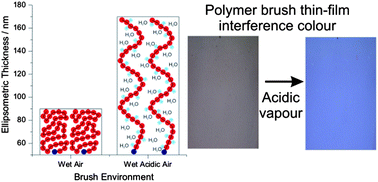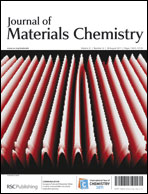Weak polyelectrolyte brushes exhibit pH-responsive swelling behaviour, tuneable surface energy, and some promise as “smart” responsive coatings. In this paper, we demonstrate the growth of two weak polybase brushes by surface-initiated atom transfer radical polymerisation (SI-ATRP) using electrostatically adsorbed polyelectrolyte macro-initiators. Poly[2-(diethylamino)ethyl methacrylate] (PDEA) and poly[2-(diisopropylamino)ethyl methacrylate] (PDPA) brushes of 150 and 170 nm thickness respectively were grown within 22 h at 20 °C. Using in situellipsometry an acid-induced swelling transition was observed at pH 7.4 for PDEA and pH 6.5 for PDPA, similar to the pKa values reported for the corresponding free polymer chains. The kinetics of brush swelling involves an initially fast regime followed by a subsequent slower regime. Reversible surface energy switching with pH modulation was also demonstrated by contact angle goniometry. Finally, it was demonstrated that PDPA brushes respond to the presence of acidic vapours. On exposure to humid HCl vapour, such brushes become hydrophilic, resulting in water uptake and swelling, producing a visible change in the thin film interference colour.

You have access to this article
 Please wait while we load your content...
Something went wrong. Try again?
Please wait while we load your content...
Something went wrong. Try again?


 Please wait while we load your content...
Please wait while we load your content...